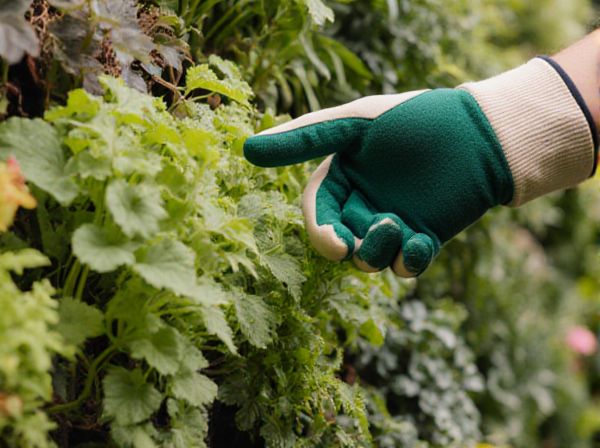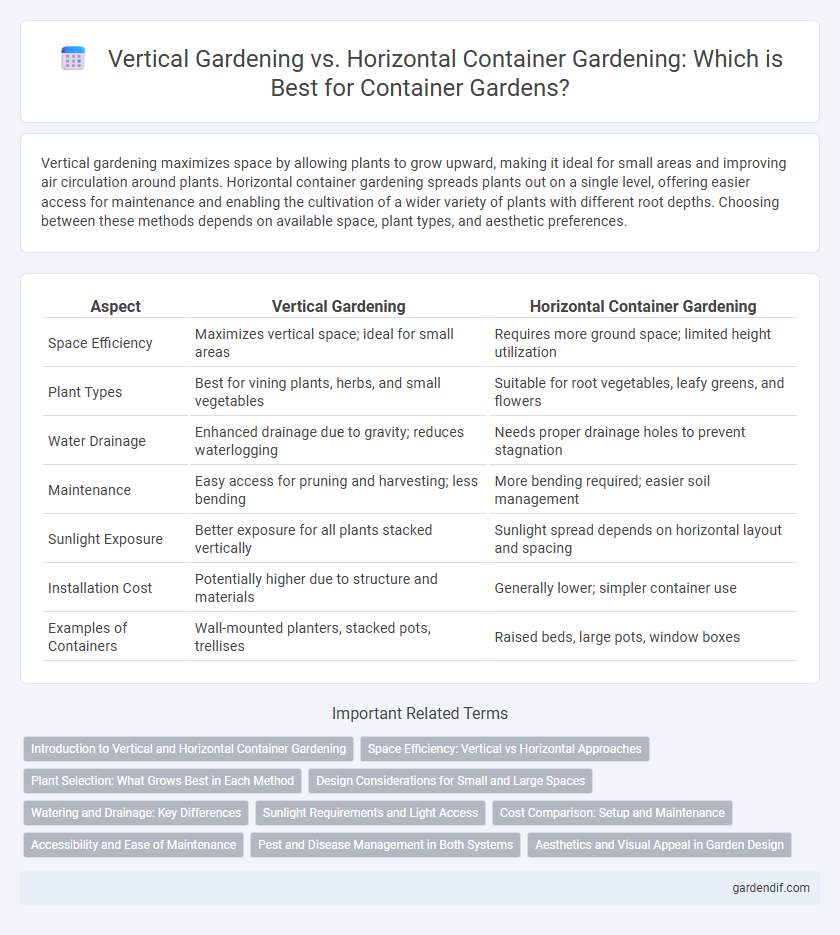
Vertical gardening vs horizontal container gardening Illustration
Vertical gardening maximizes space by allowing plants to grow upward, making it ideal for small areas and improving air circulation around plants. Horizontal container gardening spreads plants out on a single level, offering easier access for maintenance and enabling the cultivation of a wider variety of plants with different root depths. Choosing between these methods depends on available space, plant types, and aesthetic preferences.
Table of Comparison
| Aspect | Vertical Gardening | Horizontal Container Gardening |
|---|---|---|
| Space Efficiency | Maximizes vertical space; ideal for small areas | Requires more ground space; limited height utilization |
| Plant Types | Best for vining plants, herbs, and small vegetables | Suitable for root vegetables, leafy greens, and flowers |
| Water Drainage | Enhanced drainage due to gravity; reduces waterlogging | Needs proper drainage holes to prevent stagnation |
| Maintenance | Easy access for pruning and harvesting; less bending | More bending required; easier soil management |
| Sunlight Exposure | Better exposure for all plants stacked vertically | Sunlight spread depends on horizontal layout and spacing |
| Installation Cost | Potentially higher due to structure and materials | Generally lower; simpler container use |
| Examples of Containers | Wall-mounted planters, stacked pots, trellises | Raised beds, large pots, window boxes |
Introduction to Vertical and Horizontal Container Gardening
Vertical container gardening maximizes space by growing plants upward using structures like trellises or stacked pots, ideal for small areas and enhancing air circulation. Horizontal container gardening involves planting in shallow, spread-out containers, allowing easy access and adequate root space for low-growing or sprawling plants. Both methods optimize container use but differ in spatial arrangement and suitable plant types, catering to diverse gardening needs in limited spaces.
Space Efficiency: Vertical vs Horizontal Approaches
Vertical gardening maximizes space efficiency by utilizing upward growth on walls, trellises, or towers, making it ideal for small balconies or tight urban spaces. Horizontal container gardening spreads plants across the ground or flat surfaces, requiring more surface area but allowing easier access and larger plant diversity. Vertical systems optimize limited square footage while horizontal setups support extensive root zones and plant variety.
Plant Selection: What Grows Best in Each Method
Vertical gardening thrives with climbing plants such as peas, beans, cucumbers, and tomatoes that benefit from upward support and maximize vertical space. Horizontal container gardening favors root vegetables like carrots, radishes, and lettuce, which require shallow, wide containers for optimal soil depth and spread. Herbs like basil and parsley adapt well to both methods, but overall plant selection depends heavily on growth habits and container dimensions.
Design Considerations for Small and Large Spaces
Vertical gardening maximizes space efficiency by utilizing height, making it ideal for small balconies and urban environments, while horizontal container gardening requires more ground area but allows for diverse plant arrangements and larger crop yields in spacious gardens. Design considerations for vertical systems include selecting sturdy structures, ensuring adequate sunlight exposure, and optimizing irrigation to support plant growth in stacked layers. In contrast, horizontal container gardens benefit from wider planters, ease of maintenance, and flexibility in plant spacing, suitable for both compact patios and extensive garden layouts.
Watering and Drainage: Key Differences
Vertical gardening in containers typically requires more frequent watering due to increased exposure and faster soil drying, while horizontal container gardens retain moisture longer and need less frequent irrigation. Drainage in vertical setups must be carefully managed to prevent water runoff affecting lower plants, often necessitating specialized containers with multiple drainage holes. Horizontal containers generally allow for more uniform drainage, reducing the risk of waterlogging and root rot.
Sunlight Requirements and Light Access
Vertical gardening optimizes sunlight exposure by allowing plants to receive direct light on multiple levels, maximizing light access in limited spaces. Horizontal container gardening relies on surface area, often causing lower plants to experience shading from taller ones. Sunlight requirements are better met in vertical gardens as they reduce light competition and improve overall photosynthesis efficiency.
Cost Comparison: Setup and Maintenance
Vertical gardening requires initial investment in sturdy trellises or wall-mounted structures, which can increase setup costs compared to horizontal container gardening that mainly uses simple pots or trays. Maintenance expenses for vertical gardens may be higher due to the need for specialized irrigation systems and regular structural support checks, whereas horizontal container gardens typically incur lower watering and upkeep costs. Overall, horizontal container gardening offers a more budget-friendly option for gardeners seeking minimal setup and maintenance expenses.
Accessibility and Ease of Maintenance
Vertical gardening maximizes space efficiency and enhances accessibility by allowing plants to be grown at multiple levels, reducing the need for bending or kneeling during maintenance. Horizontal container gardening offers straightforward access to plants but can require more physical effort for tasks like watering, pruning, and harvesting due to its spread-out layout. Choosing between vertical and horizontal setups depends on physical ability, available space, and preferred gardening style for optimal ease of maintenance.
Pest and Disease Management in Both Systems
Vertical gardening reduces pest and disease prevalence by promoting better air circulation and minimizing soil contact, which limits fungal growth and soil-borne pathogens. Horizontal container gardening often requires more frequent monitoring and treatment because plants are closer to the soil surface, increasing exposure to pests like slugs and root diseases. Employing crop rotation, using pest-resistant varieties, and maintaining proper sanitation are critical strategies for effective pest and disease management in both vertical and horizontal container systems.
Aesthetics and Visual Appeal in Garden Design
Vertical gardening enhances garden design by creating striking visual layers and maximizing limited space, offering a dynamic, eye-catching aesthetic through climbing plants and cascading foliage. Horizontal container gardening emphasizes breadth and symmetry, providing a balanced, ground-level composition that highlights plant diversity and color contrasts. Both methods contribute unique visual appeal, with vertical setups adding height and drama, while horizontal arrangements foster harmony and ease of maintenance in garden landscapes.
Vertical gardening vs horizontal container gardening Infographic

 gardendif.com
gardendif.com